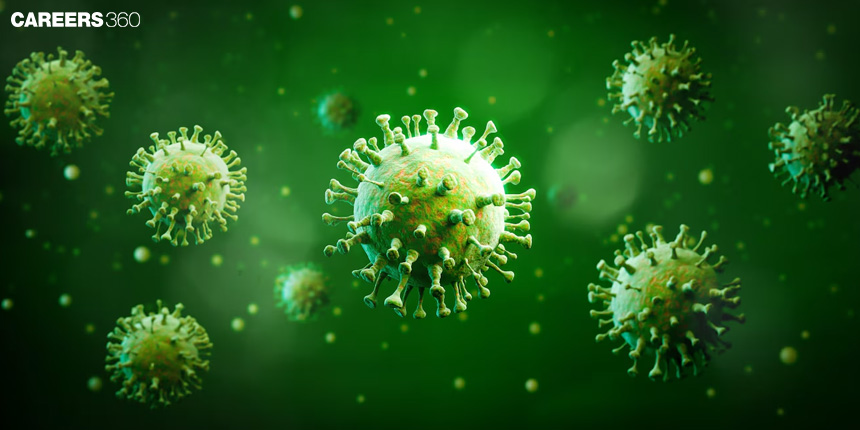Virus Definition
A virus is a microscopic infectious agent that can only replicate in the living cells of a host organism. They are composed of genetic material (DNA or RNA) enclosed in a protein coat. Viruses lack cellular structure and metabolism, making them dependent on host cells for reproduction. They infect a wide range of hosts, including animals, plants, and bacteria, often causing diseases. Virus is a topic of the chapter Biological Classification in Biology.
NEET 2025: Mock Test Series | Syllabus | High Scoring Topics | PYQs
NEET Important PYQ's Subject wise: Physics | Chemistry | Biology
New: Meet Careers360 B.Tech/NEET Experts in your City | Book your Seat now
- Virus Definition
- What is a Virus?
- Viruses Structure
- Recommended video for Virus Definition

Virus Definition
In biology, viruses are the biological agents that rain the characteristics of living and nonliving organisms; they comprise a nucleic acid core and a protein coat. This is because their capacity to penetrate cells and subvert the host cell’s machinery for their reproduction makes them important pathogens in biology and medicine. Knowledge about viruses plays an important role in understanding basic processes of life as molecular genetics and interactions between the host and virus.
Furthermore, in medicine, the study of viruses enables approaches, in diagnosing, treating, and preventing viral ailments that affect both human, animal and plant life throughout the global village. Hence, the knowledge of viruses not only helps advance the concept of biological knowledge but also stands as a key guard in defending the population's overall health.
What is a Virus?
Viruses are non-living, parasites that can only reproduce with the help of a host cell and their structure consists of a nucleic acid core either DNA or RNA surrounded by a protein capsid.
They generally contain a nucleic acid, either DNA or RNA, surrounded by a protein shell known as a capsid. Viruses are acellular and therefore unable to perform metabolic activities independently.
Bacteria are much larger than viruses, being 1 micron in size or larger while viruses are about 0. 02 to 0. 3 microns in size. Virus are of electron micrograph dimensions. 2 to 10 micrometres while cells are much bigger and can range from 10 to 100 micrometers in diameter.
Also read-
Viruses Structure
The structure of viruses is given below-
Genetic Material
Viruses can be of many types and the genetic material can be in the form of DNA or RNA. DNA viruses contain double-stranded or single-stranded DNA molecules whereas RNA viruses contain single-stranded RNA. Thus, the differences between these viruses impact the methods of replication and the enzymes necessary for the replication of the genome and transcription.
Capsid
In addition, the capsid is the hard shell that encloses the viral nucleic acid and shields it from environmental aggression. It is made up of protein particles known as capsomeres which are arranged in different symmetrical outlooks. Capsid is involved in viral attachment to host cells, entry and sheltering of the genetic material during inter-host transfer.
Envelope
An envelope is often present around some viruses and is made up of a lipid bilayer which is taken from the host cell membrane. The viruses that are enveloped in their structure obtain the coat in the process of budding off the host cell. Sometimes this envelope can carry viral glycoproteins that help the virus to identify and attach itself to the host cell. In actuality, none of the viruses possess an envelope and the viruses that do not are referred to as the non-enveloped or the naked viruses. The type of envelope affects the stability of viruses and the mode of transmission besides being sensitive to conditions such as pH and temperature.
Also Read-
| Cell Envelope | Five Kingdom Classification |
| Composition of Bacterial Cell Wall | Kingdom Monera, Protista And Fungi |
| Gram Staining | Salient features of the Kingdom Monera |
Recommended video for Virus Definition
Frequently Asked Questions (FAQs)
A virus is a small infectious agent that needs to get into a host cell to be able to reproduce. They are spherical particles made up of a nucleic acid core, (either DNA or RNA), surrounded by a protein wall. While bacteria are single-celled organisms with cells, viruses are not considered to have cells and cannot replicate independently.
The viruses adhere to specific receptors on the outer cell layer to penetrate a cell with the objective of an infection. It incorporates its genetic material into the host cell or is taken up by the cell. Inside the host cell, the viral genetic material takes control of the cell resources to build new viruses.
Viruses could be distinguished by the type of nucleic acid, with either DNA or RNA, the type of capsid: enveloped or non-enveloped, and tropism which could be animal viruses, plant viruses, or bacteriophages. Illustrations are DNA viruses that include herpesviruses, RNA viruses that include influenza viruses, and enveloped viruses such as HIV.
Immunisation involves administering the vaccine to sensitise the immune system to specific viral antigens/proteins. Often they can contain attenuated or inactivated viruses, viral proteins or the genetic materials of the viruses. This makes the immune system take note and prepare itself in case it encounters the like in future so that it can help to eliminate it thus giving immunity.
Some of the viral diseases are flu more formally known as influenza, COVID-19, Human Immunodeficiency Virus Acquired Immunodeficiency Syndrome (HIV/AIDS), Hepatitis, measles, Ebola and more. One can make different forms of an outbreak which in turn affect the severity of the viral illness and measures used to contain the spreading of the viruses.
Also Read
30 Nov'24 12:23 PM
28 Nov'24 05:34 PM
25 Nov'24 05:18 PM
23 Nov'24 10:02 AM
22 Nov'24 01:59 PM
21 Nov'24 04:58 PM
16 Nov'24 01:58 PM